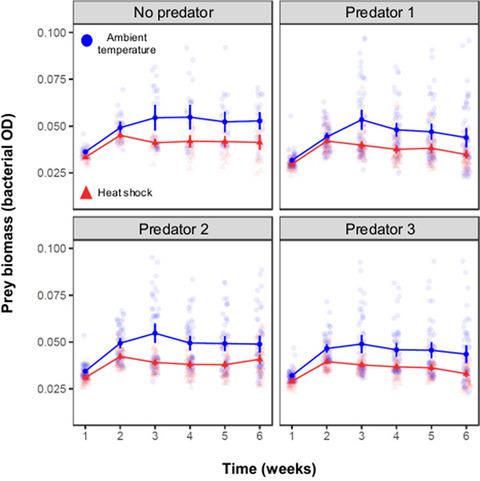当前位置:
X-MOL 学术
›
Funct. Ecol.
›
论文详情
Our official English website, www.x-mol.net, welcomes your
feedback! (Note: you will need to create a separate account there.)
Resilience of rhizosphere microbial predators and their prey communities after an extreme heat event
Functional Ecology ( IF 4.6 ) Pub Date : 2020-10-23 , DOI: 10.1111/1365-2435.13696 Madhav P. Thakur 1, 2 , Wim H. Putten 1, 3 , Fariha Apon 1 , Ezio Angelini 1 , Branko Vreš 4 , Stefan Geisen 1, 3
Functional Ecology ( IF 4.6 ) Pub Date : 2020-10-23 , DOI: 10.1111/1365-2435.13696 Madhav P. Thakur 1, 2 , Wim H. Putten 1, 3 , Fariha Apon 1 , Ezio Angelini 1 , Branko Vreš 4 , Stefan Geisen 1, 3
Affiliation

|
Climate change is known to disrupt above‐ground food chains when the various trophic layers respond differently to warming. However, little is known about below‐ground food chains involving microbial preys and their predators. Here, we study how climate warming‐induced heat shocks influence resistance (change immediately after a disturbance) and resilience (ability to recover back to pre‐disturbance levels) in rhizosphere microbial communities. We used three species of rhizosphere protists as microbial predators and six different rhizosphere bacterial communities as their prey. Protist species and bacterial communities were extracted from Centaurea stoebe—a range‐expanding plant species in the Northern Europe. We then examined the temporal dynamics of protists and bacterial communities after an extreme heat event for several generations with sufficient recovery periods. We hypothesized that bacterial community resistance and resilience after the extreme heat event would be higher particularly when extreme heat effects would negatively affect their predators. Our results show that prey community biomass was strongly reduced after the extreme heat event and persisted with lower biomass throughout the recovery period. Opposite to what was expected, predators showed negligible changes in their active density after the same heat event. However, abundances of the three predators varied markedly in their temporal dynamics independent of the extreme heat event. Extreme heat event further increased the inactive density of predators, whereas one of the predators showed a decline in its body size owing to extreme heat event. Bacterial community resistance and resilience after the extreme heat event were independent of predator presence, although species‐specific effects of predators on bacterial community resilience were different in the last week of recovery. Predator resilience (based on active predator density) also varied among the three predators but converged over time. Our results highlight that extreme heat events can be more detrimental to microbial prey communities than microbial predators when microbial predators can exhibit thermal acclimation (e.g. change in body size or become inactive) to overcome heat stress. Such thermal acclimation may promote predator resilience after extreme heat events.
中文翻译:

极端高温事件后根际微生物捕食者及其猎物群落的复原力
众所周知,当各种营养层对变暖的反应不同时,气候变化会破坏地上食物链。然而,人们对涉及微生物猎物及其捕食者的地下食物链知之甚少。在这里,我们研究了气候变暖引起的热冲击如何影响根际微生物群落的抵抗力(干扰后立即发生变化)和恢复力(恢复到干扰前水平的能力)。我们使用三种根际原生生物作为微生物捕食者,使用六种不同的根际细菌群落作为猎物。原生生物物种和细菌群落是从 Centaurea stoebe 中提取的——这是一种在北欧扩大范围的植物物种。然后,我们检查了几代极端高温事件后原生生物和细菌群落的时间动态,并具有足够的恢复期。我们假设极端高温事件后的细菌群落抵抗力和恢复力会更高,特别是当极端高温影响会对它们的捕食者产生负面影响时。我们的结果表明,在极端高温事件发生后,猎物群落生物量大幅减少,并在整个恢复期间以较低的生物量持续存在。与预期相反,在同样的高温事件后,捕食者的活动密度变化可以忽略不计。然而,这三种捕食者的丰度在独立于极端高温事件的时间动态中显着变化。极端高温事件进一步增加了捕食者的不活动密度,而其中一只捕食者的体型因极端高温事件而缩小。极端高温事件后的细菌群落抵抗力和恢复力与捕食者的存在无关,尽管在恢复的最后一周,捕食者对细菌群落恢复力的物种特异性影响不同。捕食者的弹性(基于活跃的捕食者密度)在三种捕食者之间也有所不同,但随着时间的推移趋于一致。我们的结果强调,当微生物捕食者可以表现出热适应(例如身体大小的变化或变得不活跃)以克服热应激时,极端高温事件对微生物捕食者群落的危害可能比微生物捕食者更有害。这种热适应可能会促进极端高温事件后捕食者的恢复能力。极端高温事件后的细菌群落抵抗力和恢复力与捕食者的存在无关,尽管在恢复的最后一周,捕食者对细菌群落恢复力的物种特异性影响不同。捕食者的弹性(基于活跃的捕食者密度)在三种捕食者之间也有所不同,但随着时间的推移趋于一致。我们的结果强调,当微生物捕食者可以表现出热适应(例如身体大小的变化或变得不活跃)以克服热应激时,极端高温事件对微生物捕食者群落的危害可能比微生物捕食者更有害。这种热适应可能会促进极端高温事件后捕食者的恢复能力。极端高温事件后的细菌群落抵抗力和恢复力与捕食者的存在无关,尽管在恢复的最后一周,捕食者对细菌群落恢复力的物种特异性影响不同。捕食者的弹性(基于活跃的捕食者密度)在三种捕食者之间也有所不同,但随着时间的推移趋于一致。我们的结果强调,当微生物捕食者可以表现出热适应(例如身体大小的变化或变得不活跃)以克服热应激时,极端高温事件对微生物捕食者群落的危害可能比微生物捕食者更有害。这种热适应可能会促进极端高温事件后捕食者的恢复能力。尽管在恢复的最后一周,捕食者对细菌群落恢复力的物种特异性影响有所不同。捕食者的弹性(基于活跃的捕食者密度)在三种捕食者之间也有所不同,但随着时间的推移趋于一致。我们的结果强调,当微生物捕食者可以表现出热适应(例如身体大小的变化或变得不活跃)以克服热应激时,极端高温事件对微生物捕食者群落的危害可能比微生物捕食者更有害。这种热适应可能会促进极端高温事件后捕食者的恢复能力。尽管在恢复的最后一周,捕食者对细菌群落恢复力的物种特异性影响有所不同。捕食者的弹性(基于活跃的捕食者密度)在三种捕食者之间也有所不同,但随着时间的推移趋于一致。我们的结果强调,当微生物捕食者可以表现出热适应(例如身体大小的变化或变得不活跃)以克服热应激时,极端高温事件对微生物捕食者群落的危害可能比微生物捕食者更有害。这种热适应可能会促进极端高温事件后捕食者的恢复能力。我们的结果强调,当微生物捕食者可以表现出热适应(例如身体大小的变化或变得不活跃)以克服热应激时,极端高温事件对微生物捕食者群落的危害可能比微生物捕食者更有害。这种热适应可能会促进极端高温事件后捕食者的恢复能力。我们的结果强调,当微生物捕食者可以表现出热适应(例如身体大小的变化或变得不活跃)以克服热应激时,极端高温事件对微生物捕食者群落的危害可能比微生物捕食者更有害。这种热适应可能会促进极端高温事件后捕食者的恢复能力。
更新日期:2020-10-23
中文翻译:

极端高温事件后根际微生物捕食者及其猎物群落的复原力
众所周知,当各种营养层对变暖的反应不同时,气候变化会破坏地上食物链。然而,人们对涉及微生物猎物及其捕食者的地下食物链知之甚少。在这里,我们研究了气候变暖引起的热冲击如何影响根际微生物群落的抵抗力(干扰后立即发生变化)和恢复力(恢复到干扰前水平的能力)。我们使用三种根际原生生物作为微生物捕食者,使用六种不同的根际细菌群落作为猎物。原生生物物种和细菌群落是从 Centaurea stoebe 中提取的——这是一种在北欧扩大范围的植物物种。然后,我们检查了几代极端高温事件后原生生物和细菌群落的时间动态,并具有足够的恢复期。我们假设极端高温事件后的细菌群落抵抗力和恢复力会更高,特别是当极端高温影响会对它们的捕食者产生负面影响时。我们的结果表明,在极端高温事件发生后,猎物群落生物量大幅减少,并在整个恢复期间以较低的生物量持续存在。与预期相反,在同样的高温事件后,捕食者的活动密度变化可以忽略不计。然而,这三种捕食者的丰度在独立于极端高温事件的时间动态中显着变化。极端高温事件进一步增加了捕食者的不活动密度,而其中一只捕食者的体型因极端高温事件而缩小。极端高温事件后的细菌群落抵抗力和恢复力与捕食者的存在无关,尽管在恢复的最后一周,捕食者对细菌群落恢复力的物种特异性影响不同。捕食者的弹性(基于活跃的捕食者密度)在三种捕食者之间也有所不同,但随着时间的推移趋于一致。我们的结果强调,当微生物捕食者可以表现出热适应(例如身体大小的变化或变得不活跃)以克服热应激时,极端高温事件对微生物捕食者群落的危害可能比微生物捕食者更有害。这种热适应可能会促进极端高温事件后捕食者的恢复能力。极端高温事件后的细菌群落抵抗力和恢复力与捕食者的存在无关,尽管在恢复的最后一周,捕食者对细菌群落恢复力的物种特异性影响不同。捕食者的弹性(基于活跃的捕食者密度)在三种捕食者之间也有所不同,但随着时间的推移趋于一致。我们的结果强调,当微生物捕食者可以表现出热适应(例如身体大小的变化或变得不活跃)以克服热应激时,极端高温事件对微生物捕食者群落的危害可能比微生物捕食者更有害。这种热适应可能会促进极端高温事件后捕食者的恢复能力。极端高温事件后的细菌群落抵抗力和恢复力与捕食者的存在无关,尽管在恢复的最后一周,捕食者对细菌群落恢复力的物种特异性影响不同。捕食者的弹性(基于活跃的捕食者密度)在三种捕食者之间也有所不同,但随着时间的推移趋于一致。我们的结果强调,当微生物捕食者可以表现出热适应(例如身体大小的变化或变得不活跃)以克服热应激时,极端高温事件对微生物捕食者群落的危害可能比微生物捕食者更有害。这种热适应可能会促进极端高温事件后捕食者的恢复能力。尽管在恢复的最后一周,捕食者对细菌群落恢复力的物种特异性影响有所不同。捕食者的弹性(基于活跃的捕食者密度)在三种捕食者之间也有所不同,但随着时间的推移趋于一致。我们的结果强调,当微生物捕食者可以表现出热适应(例如身体大小的变化或变得不活跃)以克服热应激时,极端高温事件对微生物捕食者群落的危害可能比微生物捕食者更有害。这种热适应可能会促进极端高温事件后捕食者的恢复能力。尽管在恢复的最后一周,捕食者对细菌群落恢复力的物种特异性影响有所不同。捕食者的弹性(基于活跃的捕食者密度)在三种捕食者之间也有所不同,但随着时间的推移趋于一致。我们的结果强调,当微生物捕食者可以表现出热适应(例如身体大小的变化或变得不活跃)以克服热应激时,极端高温事件对微生物捕食者群落的危害可能比微生物捕食者更有害。这种热适应可能会促进极端高温事件后捕食者的恢复能力。我们的结果强调,当微生物捕食者可以表现出热适应(例如身体大小的变化或变得不活跃)以克服热应激时,极端高温事件对微生物捕食者群落的危害可能比微生物捕食者更有害。这种热适应可能会促进极端高温事件后捕食者的恢复能力。我们的结果强调,当微生物捕食者可以表现出热适应(例如身体大小的变化或变得不活跃)以克服热应激时,极端高温事件对微生物捕食者群落的危害可能比微生物捕食者更有害。这种热适应可能会促进极端高温事件后捕食者的恢复能力。











































 京公网安备 11010802027423号
京公网安备 11010802027423号